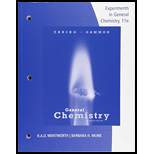
Interpretation:
The standard enthalpy change for the decomposition of water vapor to atoms in the gas phase, the
Concept Introduction:
Enthalpy of reaction:
The enthalpy of a reaction is calculated by subtracting the heat of formation of reactatns from heat of formation of products.
Bond enthalpy:
The measure of stability of molecule is bond enthalpy. The change in enthalpy is related in breaking a specific bond of 1 mole of gaseous molecule. In solids and liquids bond enthalpies are affected by neighboring molecules. There is possibility to predict the enthalpy of reaction using the average bond enthalpies. Energy is always needed for the breaking of
The enthalpy of reaction in gas phase is given by,
Answer to Problem 21.198QP
The standard enthalpy change for the decomposition of water vapor to atoms in the gas phase is
The
The standard enthalpy change for the decomposition of hydrogen peroxide vapor to atoms in the gas phase is
The
Explanation of Solution
Given data:
Water vapor decomposes to atoms in gas phase.
Hydrogen peroxide vapor decomposes to atoms in gas phase.
To Calculate: The standard enthalpy change for the decomposition of water vapor to atoms in the gas phase
The decomposition reaction of water vapor to atoms is written in chemical equation and the enthalpies of formation are written beneath the equation as follows,
The standard enthalpy change for the reaction is calculated as follows,
The standard enthalpy change for the decomposition reaction of water vapor to atoms is
To Calculate: The bond enthalpy of
The enthalpy for the above reaction in terms of bond energies is:
The bond enthalpy of
To Calculate: The standard enthalpy change for the decomposition of hydrogen peroxide vapor to atoms in the gas phase
The decomposition reaction of hydrogen peroxide vapor to atoms is written in chemical equation and the enthalpies of formation are written beneath the equation as follows,
The standard enthalpy change for the reaction is calculated as follows,
The standard enthalpy change for the decomposition reaction of water vapor to atoms is
To Calculate: The bond enthalpy of
The enthalpy for the above reaction in terms of bond energies is:
The bond enthalpy of
From the table 9.5, the bond energies are:
The standard enthalpy change for the decomposition of water vapor to atoms in the gas phase is calculated as
The
The standard enthalpy change for the decomposition of hydrogen peroxide vapor to atoms in the gas phase is calculated as
The
Want to see more full solutions like this?
Chapter 21 Solutions
Lab Manual Experiments in General Chemistry
- The reaction of calcium hydride, CaH2, with water can be characterized as a Lewis acid-base reaction: CaH2(s)+2H2O(l)Ca(OH)2(aq)+2H2(g) Identify the Lewis acid and the Lewis base among the reactants. The reaction is also an oxidation-reduction reaction. Identify the oxidizing agent, the reducing agent, and the changes in oxidation number that occur in the reaction.arrow_forwardAlumina, Al2O3, is amphoteric. Among examples of its amphoteric character are the reactions that occur when Al2O3 is heated strongly or fused with acidic oxides and basic oxides. (a) Write a balanced equation for the reaction of alumina with silica, an acidic oxide, to give aluminum metasilicate, Al2(SiO3)3. (b) Write a balanced equation for the reaction of alumina with the basic oxide CaO to give calcium aluminate, Ca(AlO2)2.arrow_forwardGive the formula for the acidic oxide of (a) HNO3 (b) HNO2 (c) H2SO4arrow_forward
- The amount of sodium hypochlorite in a bleach solution can be determined by using a given volume of bleach to oxidize excess iodide ion to iodine; ClO- is reduced to Cl-. The amount of iodine produced by the redox reaction is determined by titration with sodium thiosulfate, Na2S2O3; I2 is reduced to I-. The sodium thiosulfate is oxidized to sodium tetrathionate, Na2S4O6. In this analysis, potassium iodide was added in excess to 5.00 mL of bleach (d=1.00g/cm3) . If 25.00 mL of 0.0700 M Na2S2O3 was required to reduce all the iodine produced by the bleach back to iodide, what is the mass percent of NaClO in the bleach?arrow_forwardSodium perchlorate, NaClO4, is produced by electrolysis of sodium chlorate, NaClO3. If a current of 2.50 103 A passes through an electrolytic cell, how many kilograms of sodium perchlorate are produced per hour?arrow_forwardExplain these concepts Ionization enthalpy Electron gain enthalpyarrow_forward
 General Chemistry - Standalone book (MindTap Cour...ChemistryISBN:9781305580343Author:Steven D. Gammon, Ebbing, Darrell Ebbing, Steven D., Darrell; Gammon, Darrell Ebbing; Steven D. Gammon, Darrell D.; Gammon, Ebbing; Steven D. Gammon; DarrellPublisher:Cengage Learning
General Chemistry - Standalone book (MindTap Cour...ChemistryISBN:9781305580343Author:Steven D. Gammon, Ebbing, Darrell Ebbing, Steven D., Darrell; Gammon, Darrell Ebbing; Steven D. Gammon, Darrell D.; Gammon, Ebbing; Steven D. Gammon; DarrellPublisher:Cengage Learning Chemistry: The Molecular ScienceChemistryISBN:9781285199047Author:John W. Moore, Conrad L. StanitskiPublisher:Cengage Learning
Chemistry: The Molecular ScienceChemistryISBN:9781285199047Author:John W. Moore, Conrad L. StanitskiPublisher:Cengage Learning Chemistry by OpenStax (2015-05-04)ChemistryISBN:9781938168390Author:Klaus Theopold, Richard H Langley, Paul Flowers, William R. Robinson, Mark BlaserPublisher:OpenStax
Chemistry by OpenStax (2015-05-04)ChemistryISBN:9781938168390Author:Klaus Theopold, Richard H Langley, Paul Flowers, William R. Robinson, Mark BlaserPublisher:OpenStax Chemistry: Principles and ReactionsChemistryISBN:9781305079373Author:William L. Masterton, Cecile N. HurleyPublisher:Cengage Learning
Chemistry: Principles and ReactionsChemistryISBN:9781305079373Author:William L. Masterton, Cecile N. HurleyPublisher:Cengage Learning Chemistry & Chemical ReactivityChemistryISBN:9781133949640Author:John C. Kotz, Paul M. Treichel, John Townsend, David TreichelPublisher:Cengage Learning
Chemistry & Chemical ReactivityChemistryISBN:9781133949640Author:John C. Kotz, Paul M. Treichel, John Townsend, David TreichelPublisher:Cengage Learning Chemistry & Chemical ReactivityChemistryISBN:9781337399074Author:John C. Kotz, Paul M. Treichel, John Townsend, David TreichelPublisher:Cengage Learning
Chemistry & Chemical ReactivityChemistryISBN:9781337399074Author:John C. Kotz, Paul M. Treichel, John Townsend, David TreichelPublisher:Cengage Learning





